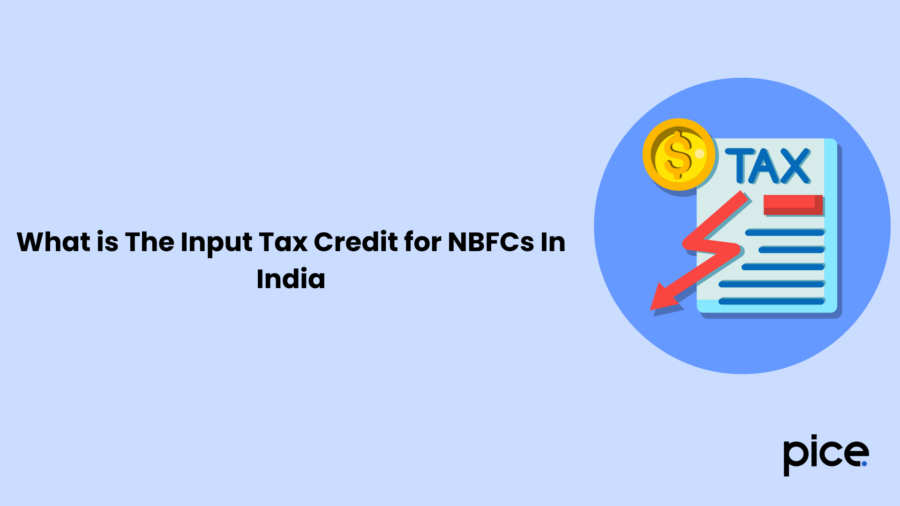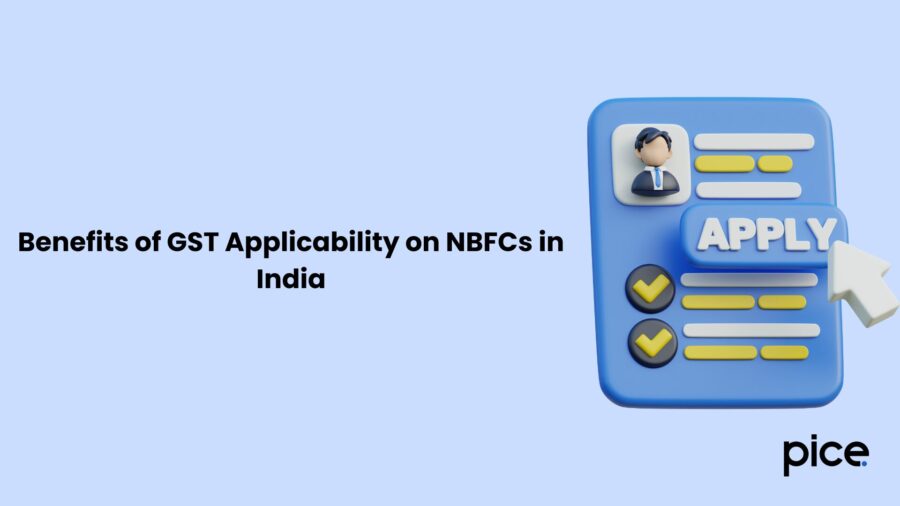Applicability and Impact of GST on Microfinance in India
- 24 Jun 25
- 11 mins

Applicability and Impact of GST on Microfinance in India
- Meaning of Goods and Services Tax (GST)
- Meaning of Financial Services
- Applicability of GST on Loans From NBFCs In India
- What is The Input Tax Credit for NBFCs In India
- The CGST Act's Section 39 requires the GST holder to file a return
- What is the Proportional Input Tax Credit Method U/S 17(2)
- What is 50% ITC Method U/S 17(4)
- Which is Better for an NBFC? Proportional ITC Method vs 50% ITC Method
- Benefits of GST Applicability on NBFCs in India
- Challenges Posed By GST before NBFCs in India
- Conclusion
Key Takeaways
- GST has streamlined taxation for NBFCs by replacing multiple indirect taxes with a unified, digital-first system.
- Loan-related transactions by NBFCs are largely exempt from GST, especially when interest is the only consideration.
- NBFCs can choose between proportional and fixed (50%) input tax credit (ITC) methods, with the latter often being more practical.
- GST compliance has added complexity, requiring state-wise registrations and detailed invoice-based return filings.
- Despite compliance hurdles, GST promotes transparency, digital governance, and cost optimization for eligible financial service providers.
GST, or Goods and Services Tax, has shown significant changes in the tax system compared to the previous tax regime. The introduction of GST in our tax regime has clearly impacted NBFCs and microfinance companies. Estimates say this will show significant variations for service sector companies compared to manufacturing or trading sector companies.
GST has had a vast impact on microfinance companies and NBFCs, changing their transactional and compliance standards. Implementing GST compliance standards in these sectors will be difficult.
In this blog, we discuss the application and impact of GST on microfinance companies and NBFCs, along with the benefits, challenges, and methods of GST applicability in India.
Meaning of Goods and Services Tax (GST)

Goods and Services Tax (GST) is an indirect tax imposed by the Indian Government on the supply of goods and services. This tax replaces different indirect taxes like VAT, excise duty, and service taxes. It is a comprehensive, multi-staged, and destination-based tax that our government levies on every transaction that adds value.
Here, multi-stage refers to the change of hands through transactions while moving along the supply chain. Value addition means combining the raw materials and making something out of them, just like a baker makes biscuits out of flour, sugar, and other raw materials.
Now, when we say destination-based, it means that GST is levied at the point of consumption. If some goods are sent to a different state for final consumption, then GST will be levied on that state.
Meaning of Financial Services
Financial services refer to a broad range of services provided by the finance industry, including banks, credit card companies, insurance companies, investment firms, and government institutions. These services facilitate various financial transactions and economic activities essential for individuals, businesses, and governments.
Under GST, financial services typically include fund management, investment advisory, stockbroking, asset management, leasing, and services related to loans and deposits. Most of these services are considered a supply of services and are taxed accordingly.
However, certain services, such as interest on loans, advances, and services by extending deposits, are exempt from GST. Financial services may be delivered through various modes, such as branch banking, online banking, ATMs, or digital platforms.
Proper classification and tax treatment are crucial in determining the GST implications, input tax credit eligibility, and compliance requirements for providers and recipients of financial services in India.
Applicability of GST on Loans From NBFCs In India
Section 2 of the CGST Act exempts non-banking financial companies and bank loan transactions from GST. This rule remains the same in the case of money-to-money transactions, as per entry 8 of the schedule of GST rates provided by the Indian GST Council.
The GST rules also state that if an NBFC levies interest fees on a loan, the loan will be exempt from GST. Here are a few things that do not fall under GST.
- A deposit, advance, or loan is extended if any consideration is represented by interest or a discount other than interest on credit card services.
- Exchange of foreign currency from one state to another or its transaction among authorised dealers in foreign exchange or among banks, and these authorised dealers do not come under GST.
What is The Input Tax Credit for NBFCs In India

Most businesses claim the input tax credit on the tax they pay on their purchases. This helps them reduce the tax burden that a firm faces based on its sales.
As of now, most banks and NBFCs choose a non-reversible option, under which they can get a 50% reversal of the CENVAT credit on inputs and input services.
If an NBFC company has registered for GST and wants to obtain an Input Tax Credit, it must provide a few documents to claim ITC. Here is a list of them.
- Tax invoice, debit note, or other supporting documents for proof of tax paid.
- Proof of any product, service, or both that they have received.
In order to claim an Input tax credit, the GST on the goods, services, or both must be paid on those supplies.
The CGST Act's Section 39 requires the GST holder to file a return
Section 39 of the Central Goods and Services Tax (CGST) Act 2017 mandates that every registered person under GST must furnish a return for each tax period. As per the current tax regime, this excludes specific categories like Input Service Distributors, non-resident taxable persons, composition levy dealers, and those responsible for TDS/TCS.
This return, commonly filed as Form GSTR-3B, must be submitted electronically. It should detail the taxpayer's inward and outward supplies; input tax credit services availed, tax payable, tax paid, and any other information prescribed by the rules.
The due date for filing this return is typically the 20th day of the month following the end of the tax period (usually monthly). However, certain taxpayers may be eligible for quarterly filing under schemes like QRMP. Filing this return is essential for declaring tax liabilities and facilitating payment. Failure to comply attracts late fees and interest, forming a crucial part of GST compliance.
Moreover, a Non-Banking Financial Company’s services that are not involved with loans are not eligible to claim an input tax credit for any inputs that do not cater to its business needs. For Example, any GST paid on food or other non-loan purposes is ineligible for an ITC claim.
What is the Proportional Input Tax Credit Method U/S 17(2)
According to section 17(2) of the CGST Act, the claimable amount of an input tax credit is limited. This depends on the taxable supplies, including zero-rated supplies. This section says that when an NBFC uses any partly taxable supplies, such as capital goods, inputs, etc are exempted from the CGST Act.
What is 50% ITC Method U/S 17(4)
As per section 17(4), an NBFC can claim an input tax credit at a fixed rate of 50% on all its credits under the 50% ITC method. After this, the remaining ITC will become null, regardless of whether or not those inputs were used for making taxable supplies.
This section further states that the tax paid on the supply of services from one registered person to another registered person with the same PAN number will not be eligible to claim the 50% input tax credit. This means they would not qualify for 50% ITC if they supply to a separate GST holder under the same business.
Which is Better for an NBFC? Proportional ITC Method vs 50% ITC Method
Comparatively, the 50% input tax credit method under section 17(4) is more suitable for NBFCs. This method allows them to claim a fixed 50% credit facility on ITC rather than a limited ITC that applies only to taxable supplies.
The 50% input tax credit method streamlines the numerous loan-related transactions that they have to make, as there is a fixed ITC rate. This shows the positive impact of GST on microfinance companies and Non-Banking Financial Companies.
Benefits of GST Applicability on NBFCs in India

The introduction of GST in India has shown some positive impacts on NBFCs and microfinance companies. Here is a list of some key benefits of GST for NBFCs.
- One Central Indirect Tax
GST replaced all other indirect taxes such as VAT, purchase, sales, excise duty, etc. This simplified the process and made tax calculations easier.
- Digitally Equipped
The GST tax system is digitally equipped. This helps large non-banking financial sector companies streamline their tax filing management. GST governance is equipped with e-filing and online settlement of business compliances, reducing compliance burdens.
- Balanced Operational Cost
As per the rules of GST, only lending companies like NBFCs, which have an annual revenue of ₹20 lakhs or more, have to register for GST. Due to this, a positive impact of GST on microfinance and NBFCs has been incorporated, as it exempts growing NBFCs from GST registration and saves them from various tax liabilities and operational costs
- Unified Model
GST provides a unified model of taxation for non-banking financial Institutions with its simplified taxation method, ultimately saving many hidden expenses.
Challenges Posed By GST before NBFCs in India
The impact of GST on microfinance companies and NBFCs has been very welcoming. However, they also had to face some challenges with GST. Here is a list of them.
- Separate GST Registrations for Different States
Under the previous taxation system, NBFCs only required one central registration for businesses in all states. However, under this new GST regime, NBFCs must get GST registration for each branch scattered across different states.
Handling multiple GST return filings has been a compliance burden for NBFCs. These multiple registrations require a lot of paperwork to show proof of tax due, ultimately increasing operational costs.
- Difficulty in Maintaining Account-Linked and Non-Account-Linked Financial Services
It can be difficult for an NBFC with branches in many states to keep track of the location of supply and where it is getting supplied. Maintaining this record in the books can be time-consuming and raise the cost of operations.
- GST Invoice Compliance Requirements
As per Section 25 of the CGST Act, businesses, including NBFCs, must provide all invoices for submitting their multiple GST return files. NBFCS have to keep track of everything from loan applications to input services, etc., and produce their invoices. The process also includes rendering all of this data and uploading the paperwork. This can be a very hefty job for a large NBFC company.
- Multiple Assessments
A large NBFC company has scattered branches across different states. Various authorities in these states might have different viewpoints regarding GST compliance, which could create legal challenges.
Conclusion
GST has significantly transformed the taxation landscape for NBFCs and microfinance companies in India. While it has streamlined tax processes, offered uniformity, and introduced digital compliance measures, it has also brought operational and compliance challenges, particularly with multiple state registrations and complex input tax credit norms.
NBFCs must adapt to proportional and fixed ITC methods based on their business structure and compliance capacity. Balancing the benefits and drawbacks, GST has pushed NBFCs toward greater transparency and accountability, though the path to full compliance remains demanding. Overall, GST is a step toward long-term tax reform in the financial services sector.
💡If you want to streamline your invoices and make payments via credit or debit card or UPI, consider using the PICE App. Explore the PICE App today and take your business to new heights.



















